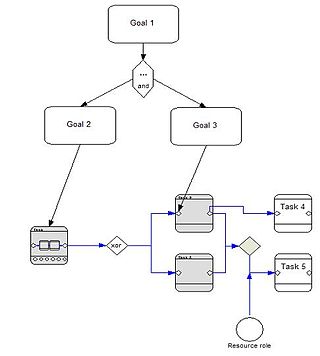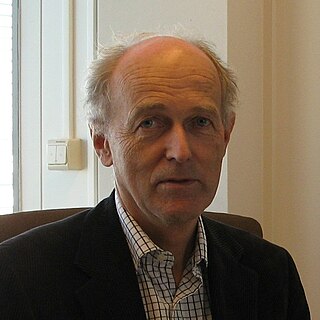Related Research Articles
Software design is the process by which an agent creates a specification of a software artifact intended to accomplish goals, using a set of primitive components and subject to constraints. Software design may refer to either "all the activity involved in conceptualizing, framing, implementing, commissioning, and ultimately modifying complex systems" or "the activity following requirements specification and before programming, as ... [in] a stylized software engineering process."
Software development is the process of conceiving, specifying, designing, programming, documenting, testing, and bug fixing involved in creating and maintaining applications, frameworks, or other software components. Software development involves writing and maintaining the source code, but in a broader sense, it includes all processes from the conception of the desired software through to the final manifestation of the software, typically in a planned and structured process. Software development also includes research, new development, prototyping, modification, reuse, re-engineering, maintenance, or any other activities that result in software products.
A modeling language is any artificial language that can be used to express information or knowledge or systems in a structure that is defined by a consistent set of rules. The rules are used for interpretation of the meaning of components in the structure Programing language.

In systems engineering, information systems and software engineering, the systems development life cycle (SDLC), also referred to as the application development life cycle, is a process for planning, creating, testing, and deploying an information system. The SDLC concept applies to a range of hardware and software configurations, as a system can be composed of hardware only, software only, or a combination of both. There are usually six stages in this cycle: requirement analysis, design, development and testing, implementation, documentation, and evaluation.

Data modeling in software engineering is the process of creating a data model for an information system by applying certain formal techniques.

James Reginald Cordy is a Canadian computer scientist and educator who is Professor Emeritus in the School of Computing at Queen's University. As a researcher he is most recently active in the fields of source code analysis and manipulation, software reverse and re-engineering, and pattern analysis and machine intelligence. He has a long record of previous work in programming languages, compiler technology, and software architecture.
Peter Pin-Shan Chen is a Taiwanese American computer scientist. He is a (retired) distinguished career scientist and faculty member at Carnegie Mellon University and Distinguished Chair Professor Emeritus at LSU. He is known for the development of the entity–relationship model in 1976.
The World Wide Web has become a major delivery platform for a variety of complex and sophisticated enterprise applications in several domains. In addition to their inherent multifaceted functionality, these Web applications exhibit complex behaviour and place some unique demands on their usability, performance, security, and ability to grow and evolve. However, a vast majority of these applications continue to be developed in an ad hoc way, contributing to problems of usability, maintainability, quality and reliability. While Web development can benefit from established practices from other related disciplines, it has certain distinguishing characteristics that demand special considerations. In recent years, there have been developments towards addressing these considerations.

A metamodel or surrogate model is a model of a model, and metamodeling is the process of generating such metamodels. Thus metamodeling or meta-modeling is the analysis, construction and development of the frames, rules, constraints, models and theories applicable and useful for modeling a predefined class of problems. As its name implies, this concept applies the notions of meta- and modeling in software engineering and systems engineering. Metamodels are of many types and have diverse applications.
A conceptual model is a representation of a system. It consists of concepts used to help people know, understand, or simulate a subject the model represents. In contrast, physical models are physical object such as a toy model that may be assembled and made to work like the object it represents.
Object-oriented analysis and design (OOAD) is a technical approach for analyzing and designing an application, system, or business by applying object-oriented programming, as well as using visual modeling throughout the software development process to guide stakeholder communication and product quality.

Structured analysis and design technique (SADT) is a systems engineering and software engineering methodology for describing systems as a hierarchy of functions. SADT is a structured analysis modelling language, which uses two types of diagrams: activity models and data models. It was developed in the late 1960s by Douglas T. Ross, and was formalized and published as IDEF0 in 1981.

Extended Enterprise Modeling Language (EEML) in software engineering is a modelling language used for Enterprise modelling across a number of layers.
Brian Henderson-Sellers is an English computer scientist residing in Sydney, Australia, and Professor of Information Systems at the University of Technology Sydney. He is also Director of the Centre for Object Technology and Applications at University of Technology Sydney.

ConceptBase is a deductive and object-oriented database management system developed at University of Skövde. Earlier development was done at University of Passau (1987-1992), University of Aachen (1992-2003), and University of Tilburg (1997-2013). It is mainly used for conceptual modeling and metamodeling in the domain of software engineering and related domains. ConceptBase.cc is free and open-source software.

Jean Leonardus Gerardus (Jan) Dietz is a Dutch Information systems researcher, Emeritus Professor of Information Systems Design, and part-time Professor of Enterprise Engineering at the Delft University of Technology, known for the development of the Design & Engineering Methodology for Organizations. and his work on enterprise ontology.

Semantic data model (SDM) is a high-level semantics-based database description and structuring formalism (database model) for databases. This database model is designed to capture more of the meaning of an application environment than is possible with contemporary database models. An SDM specification describes a database in terms of the kinds of entities that exist in the application environment, the classifications and groupings of those entities, and the structural interconnections among them. SDM provides a collection of high-level modeling primitives to capture the semantics of an application environment. By accommodating derived information in a database structural specification, SDM allows the same information to be viewed in several ways; this makes it possible to directly accommodate the variety of needs and processing requirements typically present in database applications. The design of the present SDM is based on our experience in using a preliminary version of it. SDM is designed to enhance the effectiveness and usability of database systems. An SDM database description can serve as a formal specification and documentation tool for a database; it can provide a basis for supporting a variety of powerful user interface facilities, it can serve as a conceptual database model in the database design process; and, it can be used as the database model for a new kind of database management system.
Colette Rolland is a French computer scientist and Professor of Computer Science in the department of Mathematics and Informatics at the University of Paris 1 Pantheon-Sorbonne, and a leading researcher in the area of information and knowledge systems, known for her work on meta-modeling, particularly goal modelling and situational method engineering.
Model Driven Interoperability (MDI) is a methodological framework, which provides a conceptual and technical support to make interoperable enterprises using ontologies and semantic annotations, following model driven development (MDD) principles.

Juan Pavón is a Spanish computer scientist, full professor of the Complutense University of Madrid (UCM). He is a pioneer researcher in the field of Software Agents, co-creator of the FIPA MESSAGE and INGENIAS methodologies, and founder and director of the research group GRASIA: GRoup of Agent-based, Social and Interdisciplinary Applications at UCM. He is known for his work in the field of Artificial Intelligence, specifically in agent-oriented software engineering.
References
- ↑ Wooldridge, Michael. An introduction to multiagent systems. John Wiley & Sons, 2009.
- ↑ Padgham, Lin, and Michael Winikoff. Developing intelligent agent systems: A practical guide. Vol. 13. John Wiley & Sons, 2005.
- ↑ John Mylopoulos at the Mathematics Genealogy Project
- ↑ Honorary Doctorate for Computer Scientist John Mylopoulos, 14/05/2012
- ↑ John Mylopoulos, Department of Computer Science, University of Toronto, Accessed 09.2014.
- ↑ Borgida, Alexander T., ed. Conceptual modeling: foundations and applications: Essays in honor of John Mylopoulos [ permanent dead link ]. Vol. 5600. Springer, 2009. p. IX